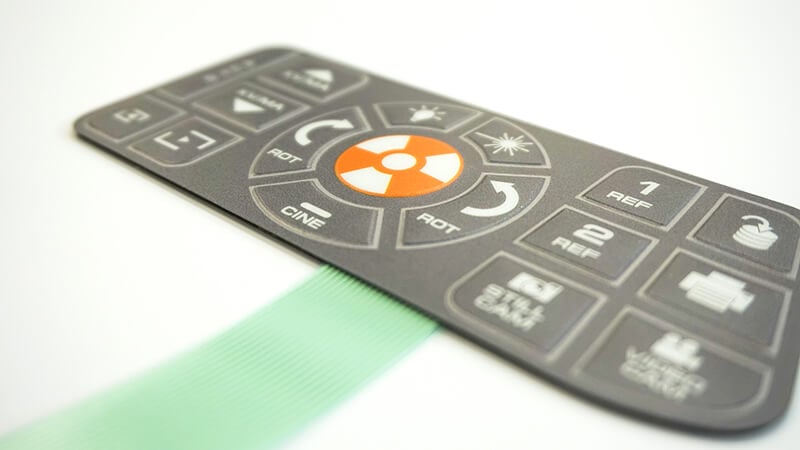Just How Membrane Layer Switches Contribute to the Durability of Electronic Control Panels
Membrane buttons play a vital duty in improving the durability of electronic control panels, largely through their multi-layered building and construction which supplies effective protection against ecological factors such as moisture and dirt. The absence of relocating components dramatically reduces the chance of mechanical failures, making membrane switches over suitable for requiring applications.
Meaning of Membrane Layer Buttons

Membrane layer switches are made to be slim and light-weight, making them ideal for applications where area is restricted. They can be manufactured in different shapes, dimensions, and shades, using adaptability in design that fulfills visual and functional requirements. Additionally, membrane layer switches can include numerous innovations, such as responsive feedback and LED indicators, improving customer experience.
Due to their building and construction, membrane layer switches are commonly resistant to dust, moisture, and basic wear, adding to their resilience popular settings. Their smooth design not just facilitates very easy cleansing yet also reduces the danger of mechanical failing, making them a recommended selection for producers seeking trusted interface in their electronic control panels.
Defense Versus Environmental Variables
The style of membrane layer switches inherently provides a level of security against various ecological factors, which is vital for maintaining functionality in tough conditions - Membrane Switch. These buttons are typically constructed with layers of versatile products that secure inner elements from moisture, dirt, and impurities. By encapsulating the circuitry, membrane layer changes minimize the danger of short circuits and deterioration, which can substantially hinder performance
Furthermore, using robust adhesives and sealers throughout manufacturing boosts their resistance to environmental challenges. Membrane switches can endure exposure to chemicals and solvents, making them ideal for markets such as food processing and medical care, where hygiene and sanitation are extremely important. Their smooth surface area layout likewise protects against the accumulation of dust and microorganisms, promoting much easier cleansing and upkeep.
Temperature level fluctuations are an additional ecological problem, and membrane layer buttons are engineered to work efficiently throughout a wide variety of temperature levels (Membrane Switch). This adaptability makes certain that control board continue to be functional in various setups, from commercial atmospheres to customer electronic devices
Influence On User Communication
Individual communication with electronic control board is substantially affected by the layout and capability of membrane layer switches. These switches provide a responsive interface that improves the general customer experience, enabling user-friendly navigating and control. Their receptive nature guarantees that customers obtain prompt feedback upon activation, which is important for jobs calling for precision and performance.
In addition, the smooth surface of membrane layer changes facilitates easy cleaning and maintenance, promoting user confidence in the reliability top article of the interface. This cleanliness is particularly important in atmospheres where hygiene is critical, such as medical or food processing settings. Additionally, the compact and lightweight layout of membrane layer switches over adds to the visual charm of control panels, motivating user engagement through a modern and streamlined appearance.
In addition, the combination of visual elements, such as printed symbols and backlighting, aids customers promptly recognize features, reducing the finding out contour related to brand-new tools. Consequently, customers can run gadgets a lot more efficiently, leading to increased performance and satisfaction. In recap, membrane switches play a crucial function in enhancing customer communication by integrating functionality, aesthetics, and ease of usage, inevitably causing page improved functional efficiency.
Design Adaptability and Modification
Style flexibility and customization are crucial aspects of membrane buttons, making it possible for makers to tailor digital control panels to details applications and individual needs. This flexibility enables the assimilation of various style elements, such as colors, graphics, and appearances, which can enhance the aesthetic allure and individual involvement of the control panel.
Membrane layer buttons can be personalized in size and shape, accommodating a vast variety of tools and applications, from industrial equipment to consumer electronic devices. This versatility makes sure that suppliers can create user-friendly interfaces that line up with customer assumptions and operational requirements. Furthermore, the capacity to include unique functions such as backlighting or responsive responses better enhances usability, enabling a much more interactive experience.
In addition, the manufacturing process for membrane switches supports the rapid prototyping of styles, allowing makers to repeat and improve their principles promptly. This capacity not just accelerates link the development timeline but also ensures that the final product meets specific functional and aesthetic standards.

Cost-Effectiveness and Durability
Cost-effectiveness and durability are considerable advantages of membrane switches, making them an attractive alternative for suppliers and end-users alike. These buttons are typically cheaper to create than standard mechanical switches, primarily due to their streamlined production processes and the decreased number of parts needed. This expense advantage expands not just to preliminary production yet likewise to long-term functional costs, as membrane buttons commonly need less upkeep and have a lower failing price.
In addition, the longevity of membrane layer switches adds to their general value. Created from resilient materials, they are immune to environmental variables such as wetness, dust, and chemicals, which can cause premature wear in various other switch types. The absence of relocating parts decreases mechanical failure, allowing membrane layer switches to preserve functionality over prolonged periods.
This longevity is especially beneficial in applications calling for consistent efficiency under requiring conditions, such as clinical devices and industrial tools. Ultimately, the mix of cost-effectiveness and longevity makes membrane switches over an economically feasible choice for makers, providing reputable remedies that endure the examination of time while optimizing monetary factors to consider.
Conclusion
In final thought, membrane layer buttons significantly boost the durability of electronic control panels through their robust construction and protective features - Membrane Switch. Overall, membrane layer switches over stand for a reliable and cost-efficient selection for enhancing the durability and functionality of electronic control systems.